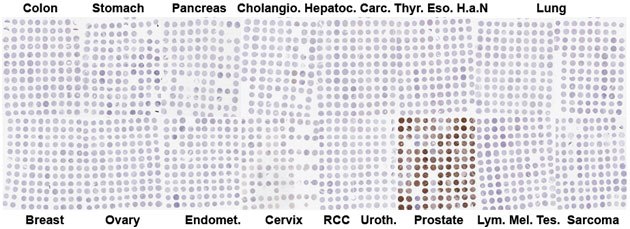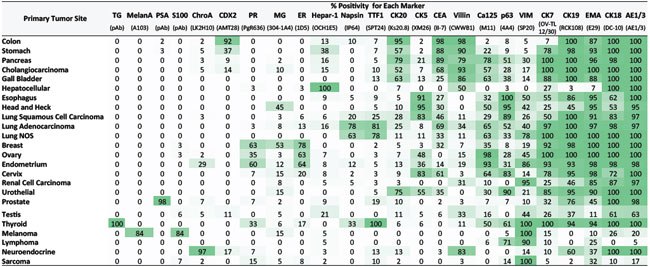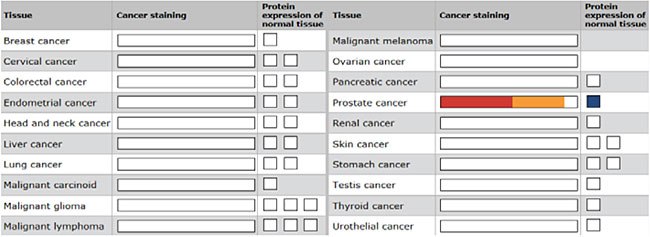Tissue Markers for Cancer Diagnostics
Gabriela Gremel1, Julia Bergman Larsson1, Per-Henrik Edqvist1, Sanjay Navani2, Mathias Uhlén3, Fredrik Pontén1
1Uppsala University, Uppsala, Sweden, 2Lab Surgpath, Mumbai, India, 3Royal Institute of Technology, Stockholm, Sweden
Poster - The Human Protein Atlas
Background
Immunohistochemistry (IHC) represents an indispensable tool in cancer diagnostics. It adds information on protein expression on top of tissue morphology and can be used to verify or reject a tentative diagnosis. While most cancer patients present with malignancies that can be ascribed to a defined primary site, in 2-8% of all cases, no primary tumor can be detected despite exhaustive diagnostic examination. Since choice of therapy and prediction of survival in general are based on the primary tumor type, these patients represent a major diagnostic and therapeutic challenge.
Tissue Microarray Cohort
In a quest to identify novel, cancer type specific markers, a unique tissue microarray (TMA) cohort, containing material originating from 22 different primary tumor sites, was assembled (Table 1). To create a basis for all further analyses, the cohort was stained immunohistochemically for 24 well-established tumor markers (Figure 1 and Table 2).
Table 1. Summary of material included in the TMA cohort.

Figure 1. Representation of TMA cohort. All cases were arrayed as duplicate cores onto 16 TMA slides and immunohistochemically stained according to a standard protocol. DAB (brown) was used as a chromogen and hematoxylin (blue) as counterstain. Exemplary IHC staining results for Prostate Specific Antigen (PSA) are shown.
True cell type specific markers are rare and most developed for hematopoietic tumors. For solid tumors, few specific markers exist, e.g. MelanA as a specific marker for melanoma (Table 2). For adenocarcinoma and squamous cell carcinoma such markers are exceedingly rare, mainly PSA (prostate cancer) and thyroglobulin (thyroid cancer) (Table 2). The application of marker panels or decision trees may increase the diagnostic accuracy. However, there remains an unmet need for identifying novel, better cancer markers.

Table 2.Table IHC results from established diagnostic markers.
The Human Protein Atlas platform represents a unique resource for the identification of novel, cancer type-specific proteins1,2 (Figure 2). A thorough database search in combination with a strategy to mine publicly available and in-house generated transcriptome data has generated a list of candidate proteins, shortly to be analyzed on the presented TMA cohort.

Figure 2.Example of antibody staining data in a range of cancer types as found under www.proteinatlas.org.
References
The HPR project is funded by the Knut & Alice Wallenberg foundation. The atlas is part of the HUPO Human Antibody Initiative (HAI).
To continue reading please sign in or create an account.
Don't Have An Account?